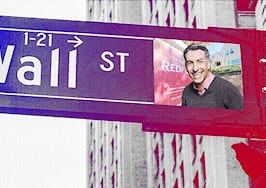Over the past 19 years, Seattle-based Redfin has been shaking up the industry, first with the introduction of its discount model and then with the rollout of its innovative home search platform alongside Zillow, Trulia, and other competitors leading the charge into the digital age.
Since then, Redfin has kept wielding technology to create a streamlined end-to-end experience for consumers and agents alike, as everyone tries to keep in step with a rapid-fire housing market. Chief Growth Officer Christian Taubman is at the center of Redfin’s marketing and product development strategy, often being the connecting thread between the engineers who create solutions and the marketers who are charged with telling the story of those solutions.
The responsibility of marrying technology and marketing has become more important than ever, as agents and consumers look for the solutions that help them navigate a world marred by coronavirus. Here’s what Taubman has to say about what lies ahead.
You’ve had an enviable career, which includes eight years at Amazon. What prompted you to jump into the world of real estate with Redfin?
A couple of things [drew me to Redfin]. One is just real estate. [Real estate] is something that is really important to a lot of people. It’s the biggest financial purchase that people obviously make in their lives, and it’s super emotionally important as well. It’s about choosing where you’ll live and for many people, where you’ll raise a family. I’ve always been drawn towards things that matter to people and things that are going to change their lives in some way. Life is short — you want to be working on things that matter.
Redfin, in particular, was exciting because of the combination of agents and technology, which unlocks the ability to make real estate a lot better, because it is very complicated and stressful and hard in many ways. I think Redfin has done a lot to make that process simpler, and there’s a lot more to do.
But like many of the most interesting challenges or problems or opportunities out there in the world, I think it has to do with the interplay of technology and actual real people out there serving customers as well.
At Inman, we spend a lot of time writing about the role of technology in real estate, and how agents can use tech in their favor. Before Amazon and Redfin, you were a software engineer, so you really know about the nuts and bolts of creating a tech solution. How has that experience informed how you approach your work at Redfin?
My undergrad degree is in computer science, and I started my career writing software. One of the main things that I took away from that part of my career was just the power of software to scale things. You can build something once and then leverage it over and over to make things better, either for end consumers or for the people who are serving those consumers.
That’s something that I keep top of mind every day because I think there are really big, exciting and interesting things that we can do for consumers and agents that involve technology. How can we help consumers tour a home more quickly? How can we help customers put in really good offers on houses in a crazy market, where it’s sometimes hard to figure out what you need to do to win?
We can leverage agents’ experience and judgment, but we can also empower the agents with technology and better information to help guide their customers. I don’t think software is always the solution, but it is something that scales really well. So pretty much every day, I’m thinking about how can we do something that’s really going to scale up well, and impact a lot of people. [I also think about] what software is good for and what’s it not good for.
You bring up a good point. As we deal with an increasingly digitized world, there’s the temptation to think tech can fix everything. How do you go about figuring out when tech is or isn’t the best fix?
A lot of it is really thinking about the problem are we trying to solve and the characteristics of that problem. For example, consumers do real estate transactions very infrequently and one problem they have is just wanting to be guided through the process. I think it’s helpful to have an experienced person to talk to, which is part of the really important role agents play. But then there are aspects that lend themselves much more to software.
For example, helping consumers get in homes really quickly and confirm those tours is not necessarily always easy, but we can automate a bunch of the process by building software that just makes it easier for other employees who are not out directly serving customers to confirm these tours and get customers into homes. We can really bring our technology power to bear on those problems.
Then you allow the agents to focus on the things that they are able to do best, which is leveraging their expertise and their guidance through those in-person, human-to-human interactions.
As I mentioned before, you spent eight years at Amazon before going to Redfin. What lessons and strategies did you learn there that have come in handy in your role as chief growth officer?
I would say two things. First, the sort of business of working with the real world and employees who are out there doing things for customers in the real world, and using technology to scale is something that Amazon does a lot of. You click ‘Buy Now’ and the thing shows up on your doorstep. But there’s a lot of physical real-world work behind that.
For example, one of the things I worked on at Amazon was free same-day delivery. Part of it is working backward from the customer and saying, ‘Hey, people would really love free delivery the same day.’ But can we make the economics work?
Part of making that economics work is figuring out how are we going to make it easier and better for the people who need to fulfill the delivery of those packages that quickly? How are we going to make that all work with software? How are we going to make it more efficient, so we can bring this great thing to customers?
The other thing I would say about Amazon is it’s really very focused on customers. Amazon relentlessly works backward from what’s going to be good for customers, figures out where things are going and invests for the long term towards that. So, that too is something that I got a lot of experience and a lot of practice with.
And again, I think that is very much part of Redfin’s DNA as well. It’s looking at not just how things are today, but how things are going to be several years from now. And going ahead and investing to set ourselves up for that all in service of, ‘Hey, how should this really work best for consumers?’
So what does the execution of these ideals look like on a day-to-day basis, especially as you equally have your hands in product development as you do in marketing?
There isn’t an average day. Let me try to synthesize one, they’re always different, but I’ll blend them all together to make a kind of common one. It might be talking to agents and hearing what’s going on out in the field. What are they experiencing? What are they hearing from customers? That’s always really important and informative for a bunch of other decisions.
It might be meeting with creative teams on marketing email ideas for how we’re going to tell our story next year. We spend a fair amount of time ideating on different ways to bring messages home to consumers. Or it might be meeting with product teams on what the next inventive ideas are. There’s some really good interplay between that, and the two things I had mentioned before.
You can see where we have this idea that grew out of something we could do with the software or something we’ve seen with how customers are interacting with our products. We can marry that with how are we thinking about telling the story and bringing the message home to consumers, which is a lot about what consumers need and what do they need, but they don’t know that they need it.
Part of my job is drawing connections across those things because I’m sitting in those different kinds of meetings and sessions. I can help make sure our product ideas benefit from what our creative teams have thought about, and from what our agents are saying about what they’re hearing from the customers they’re interacting with.
What are some of the mistakes or missteps you’ve made during your time as chief growth officer? How have those moments helped you get better at drawing the connections, which seems to be a huge chunk of your role?
That’s a great question. I make mistakes all the time. I think like a lot of leaders in a lot of companies, I was impressed at how productive we were able to be early in the pandemic, and even through the middle of the pandemic, working remotely. Our employees did a great job of sort of adapting and rallying. But over time, and especially recently, I realized, whoa, people, really do need some level of in-person interactions as they gain a lot of benefit from that.
It was just a really interesting realization that, to some extent, it takes time to see and figure out some of these things as a leader. I think, if I were doing it over again, I would lean in harder earlier on facilitating ways for people to get together in person safely, even in small groups and things like that. Because we’re all human, and we all need that connection.
It’s not about whether someone’s “working” remotely or not. It’s about in this new world, where there is a lot more flexibility about whether people are working from home to build those meaningful interactions between employees. So that’s definitely informed my leadership going forward.
Something a little closer to marketing, in particular, is we’ve been thinking more about the journey of someone who is maybe buying a home and selling a home and the right time in the right ways to help them understand their options for selling. Redfin has a lot of good options for folks who are selling their homes. But a lot of times people start out really thinking about the next time they’re gonna buy and so for a little while, we thought, ‘Hey, we should focus much, much more on that.’
I think we’ve learned that that is still true to some extent, but we’ve learned more about where and when to start introducing the options for people who are able to sell to work that into their, their buying and selling journey at the appropriate time.
The pandemic has certainly thrown everyone for a loop. Outside of what you’ve already mentioned, is there anything else that pops out to you as you think about the past year?
The pandemic just put the world on fast forward in terms of the adoption of technology. So we’ve had a few years of technology evolution in one [year] basically. It’s upped the pace for consumers and, obviously, that’s because people were forced to do the things that you used to be able to do more in the real world online. That made all the tools that you might want to have online, like virtual tours and 3D scans of homes and things like that, that much more important.
The acceleration of technology adoption isn’t going to slow down and that’s really exciting. Then, a lot of people’s lives have really changed and what they want in many cases, different things in terms of where they live and whether they want to have a home office or not, as changed too. The shift in needs has really accelerated the amount of activity that’s happening, and the amount of opportunity and work for all of us.
What are the greatest opportunities and challenges for the industry in the next few years? What opportunities does Redfin see to lead the charge on innovation in product development and marketing?
Real estate agents are out there serving customers every day, and so there are just a ton of in-person touch points that happen. That’s really important, both from bringing messaging home to consumers and explaining to them how a given company can help. It’s also important in being able to provide a level of service that really does ultimately help those consumers.
I think in terms of the challenges overall, for the industry, it’s obviously still very complicated. There’s a lot in real estate and there are a number of companies chipping away at making it, making it simpler and better. I think something for all of us to think about is just bringing those messages home for consumers because they don’t want to understand the whole process and we don’t want them to have to.
So it’s more about intelligently simplifying it down for them so that we’re connecting with the needs and concerns that they have. And helping them understand some aspect of the process and how we can help. But keeping it simple and making it more simple for them, I think for all of us as an industry is the journey that we’re on.













